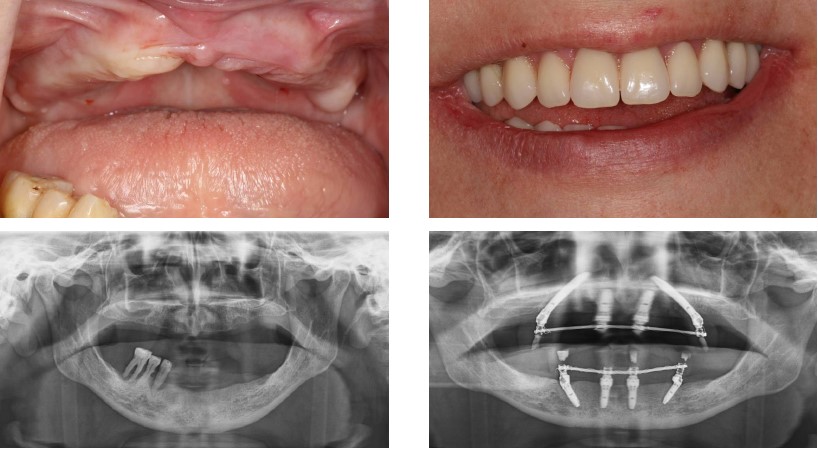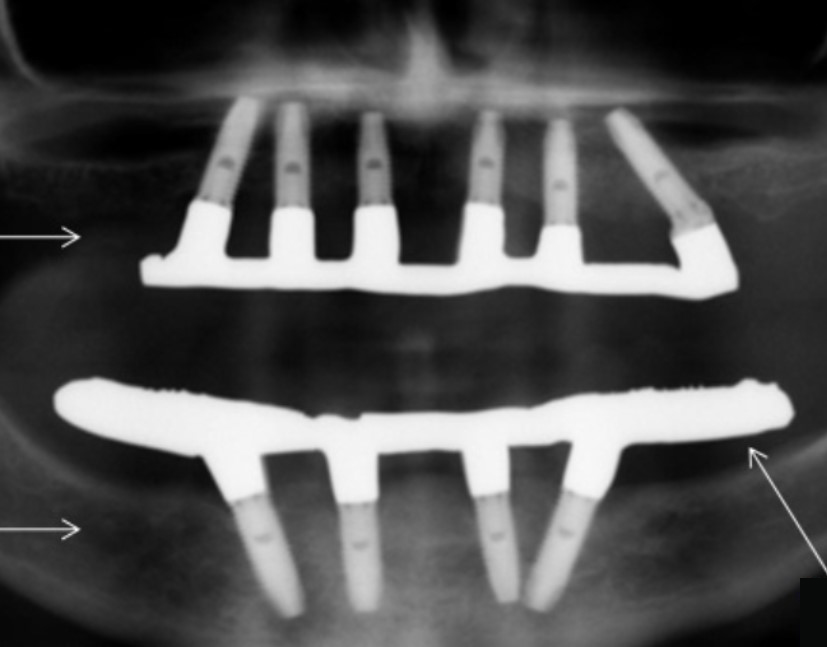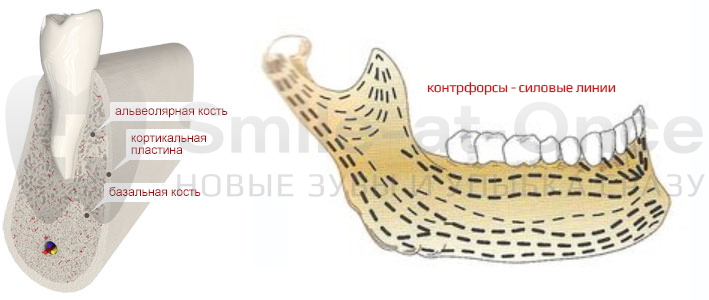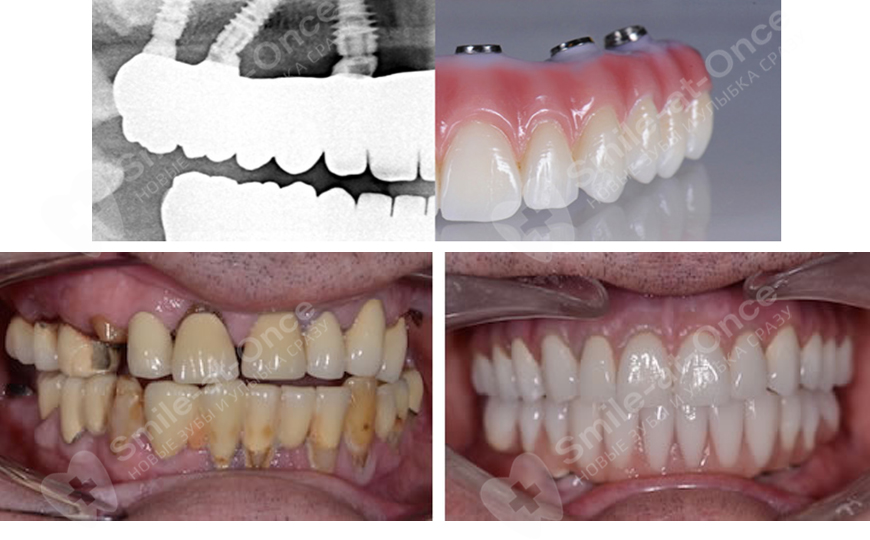Prosthetics ALL-ON-4 and ALL-ON-6: technology differences
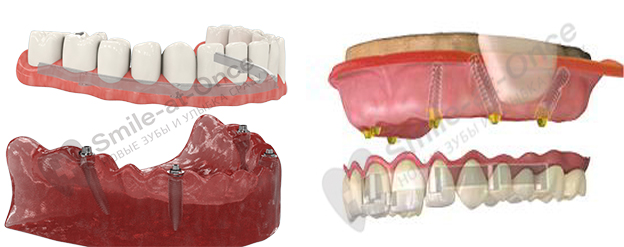
In patients with a completely toothless jaw, there are only two options for tooth restoration, in fact, removable prosthetics or dental implants.
What is better with full adentia - removable dentures or implants?
Removable prosthetics is much more common in our country than dental implantation. The explanation is very simple: removable dentures are more affordable - for example, the most inexpensive plate dentures made of acrylic will cost only 10-15 thousand rubles (depending on the clinic).
But the inconvenience of removable prosthetics is many times more:
- constant pressure and gum rubbing,
- difficulty pronouncing some sounds,
- dentures can fall out because they are poorly fixed
- not too good aesthetics
- complex ritual of care - dentures need to be removed after each meal.
Dental implantation is devoid of all these disadvantages, since dentures are firmly fixed in the mouth, they are smaller and do not rub gums, do not cause discomfort when chewing and talking, they do not need to be removed continuously for hygienic care. Implant prostheses look more natural.
Dental implants and prostheses in the absence of all teeth are more expensive than removable prosthetics. But if you consider in the long run and add the comfort that they give, there is virtually no difference in price.
Very often, patients who go to clinics for dental implants with full adentia refuse further treatment because of the price (for both jaws - at least a million rubles), too long waiting for prostheses (most often - about a year), and also the need bone growth due to its acute atrophy (occurs due to the long absence of own teeth).
However, dental implantation is actively developing and today dentists can offer patients several modern techniques that are used to restore all teeth in the mouth. This article will discuss implantation with immediate loading with all-on-4 and all-on-6 prostheses and we will talk about it. First, we compare both methods, and then consider the features of each in more detail.
Comparison of dental prosthetics technology ALL-ON-4 and ALL-ON-6
|
technology "all—on-4» |
technology "All-on-6" |
| Indications | |
| Lack of a large number or all teeth | Lack of a large number or all teeth, bone atrophy, periodontitis, periodontal disease, osteoporosis of the jaw bone |
| Contraindications | |
| Common for surgery, periodontitis, periodontal disease, osteoporosis, acute bone atrophy | General for surgery |
| Bone condition | |
| Healthy bone tissue or moderate atrophy, lack of inflammatory processes | Medium or high degree of atrophy. Possible in inflammatory processes with their simultaneous elimination |
| Implant placement while removing diseased teeth | |
| Possible - the implant is inserted into the well of the tooth just removed and instantly loaded with a prosthesis | |
| Number of implants | |
| Four: two in the front, installed directly, two in the lateral-distal, installed at an angle | Six: two in the front, installed directly, four in the side, installed at an angle |
| The level of primary stabilization of implants | |
| 30 - 45 Newtons | 2 times higher + more points of support, which means better distribution of chewing load. 60 -100 Newtons |
| Type of implants | |
| Classical root-shaped two-part implants of different sizes (abutment - a separate part) | One-piece implants with angled abutment (corrected after installation) |
| Abutment Type | |
| Multi Unit Angled Abutment | Multi-unit abutments combined with the implant in one piece |
| The bone section used to fix implants | |
| Central spongy or zygomatic bone with ZYGOMA | The basal base and cortical plate, the zygomatic bone and other lines of force of the skull, which are not susceptible to atrophy and are not subject to inflammatory processes |
| Type of prosthesis | |
| Plastic with a metal frame and elastic gum, is fixed by screw fastening through the crowns of the prosthesis. The artificial gum is designed to hide the uneven gingival margin of the natural mucous membrane, formed due to atrophy and subsidence of the alveolar ridge. | |
| Main advantages | |
|
|
| Main disadvantages | |
|
slightly higher price than all-on-4 technology. Other disadvantages of ALL-ON-4 technology are eliminated due to the greater number of support points and the use of basal implants, which are fixed in more sterile and deeper parts of the bone tissue. |
All-on-4 prosthetics
All-on-4 prosthetics dates back to the late 20th century when Portuguese doctor Paulo Malo performed the first successful treatment of a patient using only four implants. This technique was patented by Nobel Biocare, the founder of all dental implants (it was she who began to collaborate with Dr. Branemarck, who introduced the classic root-shaped implants to the world, and launched the first models for treating patients).
The essence of the all-on-4 prosthetics is that only 4 two-part implants are used to restore the complete dentition: two are fixed in the frontal zone, two in the distal or lateral section, and if the first are installed directly and parallel to each other, then two others - at an angle of up to 45 degrees. The inclination of the implants allows you to increase the area of contact between the implant and the bone, and also makes it possible to install them bypassing important anatomical structures - loose or atrophied sections of the bone, ternary nerve, and sinus.
For treatment, root-shaped implants of a special design are used. On those that are fixed at an angle, angled multi-unit abutments are used that allow you to align the position of the prosthesis and even correct the bite.
Indications and contraindications
- full adentia - restoration of up to 12 teeth in a row,
- minor bone atrophy,
- the inability or unwillingness to wear removable dentures,
- the need for quick tooth restoration - at the same time as implants are implanted,
- bone height of at least 10 mm in the upper jaw and 8 mm in the lower jaw, width - 5 mm.
Contraindications to treatment, as with classical implantation, boil down to general body problems in which surgical intervention is impossible: uncompensated diabetes, problems of the nervous, cardiovascular, circulatory systems, AIDS, HIV infection, tuberculosis, and malignant tumors.
All-on-4 prosthetics is not recommended for periodontitis and periodontosis, as well as osteoporosis of the jawbone.
Types of Implants
Nobel products are of the highest quality, time-tested and hundreds of thousands of patients. However, the treatment with the use of implants of this brand is very high (from 400-600 thousand).
Therefore, those who want to save money, but get the same high quality of treatment, will be offered implants of other brands that have existed for at least 10 years and have proven clinical studies in the long term. When choosing implants of the brands Oneway Biomed, OSSTEM, Noris Medical, Logic, the treatment will cost from 180 thousand rubles.
Advantages and disadvantages of prosthetics
- improving the quality of life of the patient: chewing, aesthetics, psychological comfort,
- reduction of treatment time to several days,
- lower cost of treatment compared to the classic two-stage protocol.
Among the disadvantages of technology - difficulties during surgery in conditions of atrophy of bone tissue, since the lack of support points leads to loosening of the entire structure. If the jawbone is not enough, the load is distributed unevenly, so the bone tissue continues to atrophy.
In addition, the implants are fixed exclusively in the spongy, central section, with its atrophy, the bone tissue sits during the installation of the implants - and this negatively affects their stability. Immediate loading may result in rejection of the bone material and the occurrence of mobility of the installed implants.
Another rather significant drawback of this technology is that most often in the area of chewing teeth there is no way to correctly place the implant. Some doctors, contrary to the protocol, install posterior implants closer to the front. The posterior areas, without receiving a chewing load, continue to atrophy, and thus there is a high risk of damage to the prosthesis and the failure of the entire structure as a whole.
An example of improperly placed implants in the distal area of the lower jaw.
“All-on-4 technology is indeed a very successful development, which we are pleased to offer our patients with complete edentulousness. But with some modifications. Firstly, only with a sufficient volume of bone tissue. The installation of these implants during atrophy, especially in an advanced stage, is fraught with the occurrence of complications and a reduction in the service life of the entire structure.
Secondly, in the original concept, a temporary prosthesis is fixed immediately after the implant placement operation. We offer our patients the installation of a prosthesis for 2 days, since the mucous tissues need to be restored - more than enough days for rehabilitation and wound healing. This eliminates the risk of developing inflammatory processes and reduces soreness, ”says Nikolai Namdakov, implantologist surgeon, member of the Russian Association of implantologists and a member of the International Implant Foundation, at the Moscow clinic“ SMILE-AT-ONCE ”.
All-on-6 prosthetics
All-on-6 prostheses or all on 6 implants is a revised and improved all-on-4 system. This method is based on practical experience with the application of the all-in-4 technology, including negative.
In 80% of cases, this method is optimal in the complete absence of teeth and bone atrophy.
When using this technology, one-part implants are used, which are fixed in the deeper parts of the jaw bone - the basal base and cortical plate (tissue membrane), and in cases of acute atrophy of the jaw bone, the zygomatic bone and other skull lines of force (buttresses) are used. These layers are stronger and harder. They consist mostly of bone partitions, not capillaries, so they do not undergo resorption, atrophy and inflammatory processes, even with a long absence of teeth. That is why all-in-six implantation is possible with periodontitis and periodontal disease, since these layers of bone tissue do not participate in the inflammatory process and allow reliable holding of implants.
The implants themselves are fixed by a minimally invasive method, that is, atraumatic, without massive incisions of the gums and bone tissue. They literally screw into the bone, while it is pressed and compacted around the implant, creating a durable shell that additionally holds the structure.
For 2-3 days after the operation, a fixed bridge is installed, which consists of plastic crowns and a metal base and elastic artificial gums, which however looks like a natural one. It is designed to combine installed implants in one group and stabilize them. Due to the fact that the patient begins to chew food immediately, natural processes are activated inside the bone and it is restored many times faster. After 1-5 years, the prosthesis can be replaced with a permanent one made of cermet or zirconium dioxide.
Indications and contraindications
- complete or absence of a large number of teeth,
- average degree of bone atrophy,
- the proximity of the maxillary sinus or mandibular nerve,
- the inability or unwillingness to wear removable dentures,
- the presence of diseased teeth to be removed,
- periodontitis and periodontosis, including in an advanced stage,
- the need for tooth restoration in smoking patients,
- osteoporosis of the jawbone.
Contraindications to treatment are almost identical to the “all-on-4” protocol, except that this technique is possible for heavy smokers, with periodontitis and periodontosis, as well as osteoporosis of the jaw bone.
Types of Implants
To perform prosthetics using the all-on-6 technology, one-piece models with angled abutment are used, which allows them to be used for immediate loading and adaptation of the denture.
Among the companies that have in their assortment models for immediate loading of the prosthesis are the brands Oneway Biomed, Noris Medical, Alpha Dent, Nobel, Ankylos.All of them have existed for more than a decade on the market and have clinically proven successful implant placement results in the long term.
“When working with the“ all for 6 ”methodology, we primarily use Oneway Biomed (Switzerland) and Alpha Dent (Germany) implants, since they are the pioneers in the field of implantation of teeth with immediate loading and have patents for the method of their installation in atrophy of bone tissue. The company has existed for almost 40 years - over the years, there have been many clinical studies of the results of treatment and a high assessment of the survival and operation of implants, ”says Nikolai Namdakov.
Advantages and disadvantages of prosthetics
- no bone grafting required
- short treatment time - dentures are fixed for 2-3 days,
- more uniform distribution of the load on the bone due to the increase in the points of support,
- the installed prosthesis stabilizes and fixes the implants in a stationary state,
- bone tissue actively "works", starting from the first day of installation of the prosthesis.
The “all by 6” technology is devoid of all the drawbacks that its predecessor has - the “all by 4” technique: implants can be installed with more atrophied bones, the entire structure lasts much longer, and there are much fewer contraindications to implantation.
Implantation Stages
- 1 day - preparation: with both methods, computer simulation is used, which allows you to carefully work out the entire treatment process in a three-dimensional version. Prior to this, computed tomography is necessarily done, a medical history is collected,
- Day 2 - installation of implants, if necessary, at the same stage, diseased teeth are removed and foci of inflammation are sanitized. Following casts.
- 3 day - installation of the prosthesis.
Patient Reviews
- Margarina P .: “I installed Nobel implants 3 years ago, using the“ all by 4 ”technology. The pleasure of saying expensive is to say nothing. But, of course, it was worth it - I was scanned all along and across, the doctor evaluated the bone for a very long time, approved the treatment plan with me. The implants are like implants, crowns, however, had to be changed, because the aesthetics of the first temporary ones are not too good. "It flew a pretty penny on the entire jaw, but the result is still 100 percent satisfied."
- Ivan Vladimirovich Dolgov: “For a long time I studied information about implantation. I am only 45, but the tooth problem has passed by inheritance - today there are practically none. I went for 2 years with a removable denture, but decided to abandon it, tired. I chose the all-on-6 technique, the doctor recommended, I heard a lot about him. I did not regret it at all - quickly, we can say that it doesn’t hurt, the result is excellent. Crowns are like native teeth. ”
- Irina K .: “Implantation is scary. But only for those who are not familiar with her. Actually, it doesn’t matter how many implants will stand, which brands you choose. The main thing is that the doctor be with his hands and do his job as a professional. First I had three implants installed. Poorly. Therefore, after 2 years she was re-prosthetized - because of atrophy, the “all by 6” method was chosen with the doctor. There were no more options. For a year now I have been eating and smiling normally. I don’t feel at all that my teeth are artificial. ”


